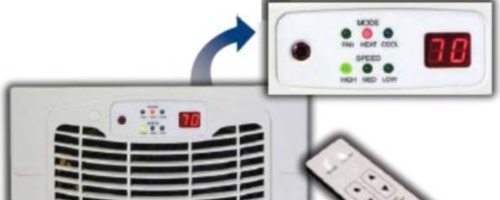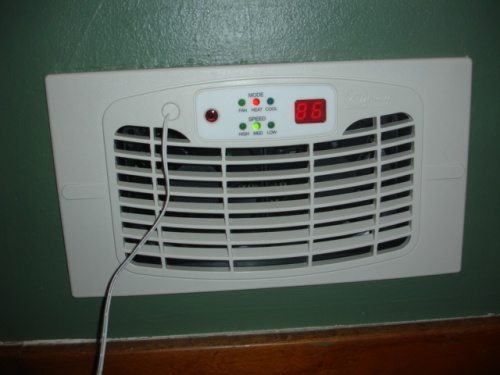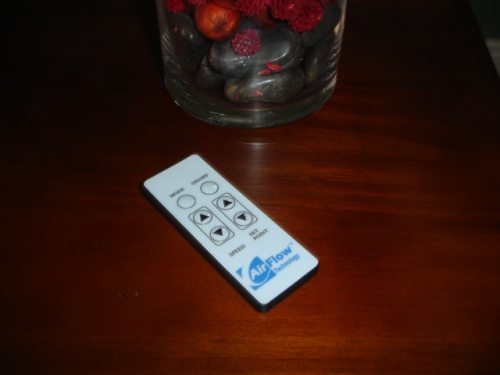
I reviewed an earlier model of the AirFlow Breeze and was not greatly impressed, but the addition of a temperature sensor in the ‘Ultra’ model makes a big difference. Let’s take a look.
Airflow Technology’s Breeze Ultra is a unit you place in a floor, wall, or ceiling vent then plug in to help move more air. Because it has a temperature sensor, it only comes on when the furnace or air conditioner is on, and you can set the temps that turn it back off.
It uses 2 low-voltage fans (bigger than, but similar to what you would find in a computer) to move the air relatively quietly. It claims 32-35 decibels, the level of a ‘soft whisper’. I am not sure it is that quiet- you can hear them running from several rooms away, but it is a much softer noise than the other Breeze I tried. According to the website, they cost less than $5 a year to operate, which seems reasonable.

Installation is similar to the other Breeze, but it only comes in one faceplate size (almost 8 x 14″). The screw holes are still not pre-drilled (this time this makes some sense since it offers 2 hole options) and it still uses your old screws (yuck). You plug in the power jack through the face plate and adjust the length of cord you want to leave out (a nice touch) and seal the hole with a plug. It also includes a blank plug if you can plug it into AC from the back.
Once plugged in, you program the settings using the included remote. Programming is easy and well-explained. I do rather wish that you did not need the remote- that the main buttons were available on the unit, but I suppose that would be tricky if it were floor or high mounted. The remote is small and well-labeled.

LEDs show mode (nicely color-coded for heat, cool, and fan only), fan speed, and the pre-set temperature to turn off at. The unit turns on when it senses the heat or a/c on, and you tell it when to turn off. I wish the display showed what temperature it was now instead. The LEDs are rather bright and I covered them with masking tape. After all, I saw what I set it to and can hear when it is on, so they are not telling me much useful and I already have enough LEDs shining in my house.
So… after not being impressed with the non-Ultra Breeze, how’d this one work?
Significantly better. This time, it was heating instead of cooling and this time I felt OK letting it run for several days unattended since it was not going to be blowing cold air all of the time. The room feels more comfortable… not by a ton, but it definitely seems to have taken the ‘chill’ out of the air. My favorite seat is next to a leaky old front door we have struggled to seal for years and I generally need a jacket and blanket to be comfy. With the Ultra running, I can omit one of those. My wife sits in a naturally warmer (but not ‘warm’) part of the room and feels a difference as well.
Would I pay $89.95 for the differences? I think it is cheaper than raising the temps a few degrees for a season, but I think other options would give our particular situation more ‘bang for the buck’. I suspect the results would be more significant in a better insulated home than in our old drafty place.
Bottom line- we have a lot of options to help stretch our heating and cooling dollars, and you have to find the ones that work for you. The AirFlow Technologies Breeze Ultra will make a big difference in a lot of situations.
Google Review Tap Cards (3-Pack) by TapFive - Tap for Instant Reviews - All Phones Compatible - Reusable Smart Tap NFC & QR - Boost Business Reviews - Powered by TapFive (3 Card Pack)
$34.90 (as of December 2, 2025 03:38 GMT -05:00 - More infoProduct prices and availability are accurate as of the date/time indicated and are subject to change. Any price and availability information displayed on [relevant Amazon Site(s), as applicable] at the time of purchase will apply to the purchase of this product.)REVLIXI Google Review Stand -Boost Reviews w/Reusable Google Review Tap Card Stand & QR Code Stand- No App or Subscription - Android & iPhone Compatible-Boost Google Reviews for Online Growth
$24.89 (as of December 1, 2025 17:54 GMT -05:00 - More infoProduct prices and availability are accurate as of the date/time indicated and are subject to change. Any price and availability information displayed on [relevant Amazon Site(s), as applicable] at the time of purchase will apply to the purchase of this product.)Product Information
| Price: | $89.95 |
| Manufacturer: | AirFlow Technology |
| Pros: |
|
| Cons: |
|



Gadgeteer Comment Policy - Please read before commenting
Why not use a simple, separate thermometer to measure the actual effect of the “Breeze” on room temperature ?
Why guess about its effects ?
…seems like an inexpensive floor fan ($10-$15) positioned near the room doorway would work as well or better better (circulating air between adjacent rooms of differing temperatures).
Just closing the air vents in other little-used/unused rooms would increase the airflow into the room(s) whose temperature you want to improve.
My home uses ceiling air vents… without easy or unobtrusive access to electrical outlets.
Also, the semi-permanent screw-mounting of ‘Breeze’ + electrical plug-in… probably violates electrical building-codes in many areas.
@Gary-
When I reviewed the original Breeze, I had a thermometer handy. This time, all I had was an IR thermometer that really did not help. I have a lot of cool tools sitting around, but sometimes you just don’t have what you need. Besides, thermometers measure temperature, not relative comfort (like wind chill, etc.)
Yes, in the earlier review, I found a plain fan did a better job in the summer, however, the Ultra will only be working when the heater or AC is on rather than moving just the ambient air around. And closing the vents in unused rooms is only really helpful if you have unused rooms. We have the heat off on two entire levels and it is still chilly often.
Obviously there is no such thing as a perfect solution for everyone, as I mentioned, but I do think the Ultra can help many situations.
User update:
In the last three weeks I have continued to notice an improvement in the room, although I also notice that the rather quite sound of the fans tend to bug me in the late evening, even on the slowest setting. Luckily, with the remote, I can click them off when I am annoyed and on again when needed.
I also note that as the outside weather fluctuates as we enter spring (late and cool here still, though), I need to adjust the temp settings rather often. Not a big deal with the remote, just an observation.
Hi Mark,
It still sounds like you are trying to solve a fairly serious situation with a very small and inexpensive appliance. These boosters look more like they are for modern houses with sealed, energy efficient climate systems that need only a couple degrees help in a single room. Again, just an observation, but if you need a jacket and a blanket in one room and not another, your house needs a great deal more help than I think any band aid will provide. If air is continuously being sucked out of your house, adding a miniature fan to a vent will solve little.